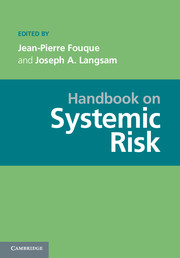Book contents
- Frontmatter
- Contents
- Contributors
- Introduction
- PART I DATA: THE PREREQUISITE FOR MANAGING SYSTEMIC RISK
- PART II STATISTICS AND SYSTEMIC RISK
- PART III MEASURING AND REGULATING SYSTEMIC RISK
- PART IV NETWORKS
- PART V SYSTEMIC RISK ANDMATHEMATICAL FINANCE
- PART VI COUNTERPARTY RISK AND SYSTEMIC RISK
- PART VII ALGORITHMIC TRADING
- PART VIII BEHAVIORAL FINANCE: THE PSYCHOLOGICAL DIMENSION OF SYSTEMIC RISK
- 23 Fear, Greed, and Financial Crises: A Cognitive Neurosciences Perspective
- 24 Bubbles, Crises, and Heterogeneous Beliefs
- 25 Systemic Risk and Sentiment
- PART IX REGULATION
- PART X COMPUTATIONAL ISSUES AND REQUIREMENTS
- PART XI ACCOUNTING ISSUES
- References
24 - Bubbles, Crises, and Heterogeneous Beliefs
from PART VIII - BEHAVIORAL FINANCE: THE PSYCHOLOGICAL DIMENSION OF SYSTEMIC RISK
Published online by Cambridge University Press: 05 June 2013
- Frontmatter
- Contents
- Contributors
- Introduction
- PART I DATA: THE PREREQUISITE FOR MANAGING SYSTEMIC RISK
- PART II STATISTICS AND SYSTEMIC RISK
- PART III MEASURING AND REGULATING SYSTEMIC RISK
- PART IV NETWORKS
- PART V SYSTEMIC RISK ANDMATHEMATICAL FINANCE
- PART VI COUNTERPARTY RISK AND SYSTEMIC RISK
- PART VII ALGORITHMIC TRADING
- PART VIII BEHAVIORAL FINANCE: THE PSYCHOLOGICAL DIMENSION OF SYSTEMIC RISK
- 23 Fear, Greed, and Financial Crises: A Cognitive Neurosciences Perspective
- 24 Bubbles, Crises, and Heterogeneous Beliefs
- 25 Systemic Risk and Sentiment
- PART IX REGULATION
- PART X COMPUTATIONAL ISSUES AND REQUIREMENTS
- PART XI ACCOUNTING ISSUES
- References
Summary
Abstract Heterogeneous beliefs are a widely observed attribute of individuals. This chapter reviews the quickly growing literature that builds on heterogeneous beliefs to explain bubbles, crises, and endogenous risk in financial markets.
The history of financial markets has been dotted with episodes of bubbles, during which market values of assets vastly exceeded reasonable assessments of their fundamental value. Asset price bubbles can lead to severe economic consequences ranging from wasteful over-investment and frenzied trading during booms to devastating financial crises and depressed real economies during busts. Economists have emphasized many aspects of bubbles and crises. Minsky (1974) advocated the view that excessive expansion of bank credit due to optimism can fuel a speculative euphoria and slowly lead the economy to a crisis. Kindleberger (1978) stressed that irrationally optimistic expectations frequently emerge among investors in the late stages of major economic booms and lead firm managers to over-invest, overpromise, and over-leverage, which sow the seeds for an eventual collapse after they fail to deliver on their promises. Shiller (2000) highlighted a host of psychological biases people use in forming a feedback mechanism, through which initial price increases caused by certain initial precipitating factors such as new technology innovations feed back into even higher asset prices through increased investor confidence and expectations. Allen and Gale (2007) focused on agency problems of professional managers who actively seek unwarranted risk, which leads to bubbles and crises.
- Type
- Chapter
- Information
- Handbook on Systemic Risk , pp. 663 - 713Publisher: Cambridge University PressPrint publication year: 2013
References
- 41
- Cited by



